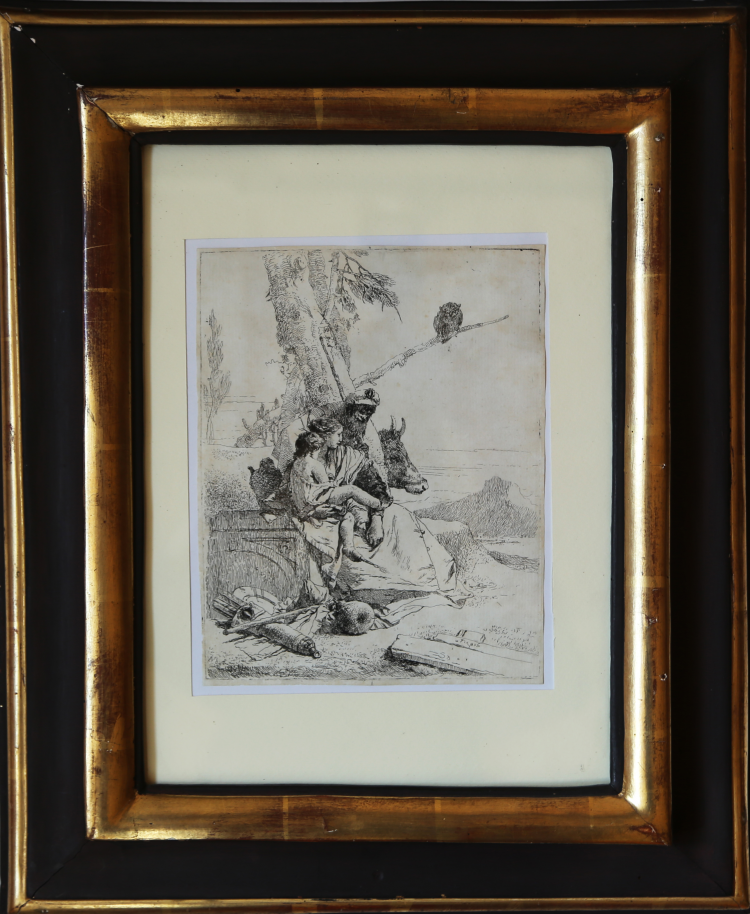




| Reference: | S38352 |
| Author | Giambattista TIEPOLO |
| Year: | 1740 ca. |
| Measures: | 178 x 225 mm |



| Reference: | S38352 |
| Author | Giambattista TIEPOLO |
| Year: | 1740 ca. |
| Measures: | 178 x 225 mm |
Etching, 1740 circa, signed at right “Tiepolo”. Plate 15 from the series of 24 “Scherzi di Fantasia”. First state, of two, before number 105added at upper right.
Good example, printed on contemporary laid paper, trimmed close to platemark, light and scattered foxing, otherwise in very good condition.
These etching belongs to the first series of 24 plates of Scherzi . Tiepolo finished the majority of the 24 plates duting 1740s, before his depature for Würzburg in 1753, bust most likely continued working on them until 1757. Unlike his first series of prints, the “Vari capriccj, the Scherzi were never published as an ensemble during Tiepolo’s lifetime; nor did any of the etchings of either series bear specific titles. It is only after Tiepolo’s death in 1770 that his son Giandomenico compiled the sheets into a distinct cycle, calling them “Libro di Scherzi di fantasia n. 24”. In the last edition of his “Catalogo”, published in 1778, the plates are reduced to 15 including the numbered ones 4 -7, 12-19, 22-23.
|
Rizzi 62.18 i/ii - Succi, p. 468 n. 59 i/ii
|
Giambattista TIEPOLO (Venezia, 1696 - Madrid, 1770)
|
He was the most renowned painter of 18th-century Italy and the last great representative of the grand tradition in Italian art. He was especially gifted as a draughtsman and as a painter in fresco. His fresco cycles and religious and mythological canvases demonstrate that he also possessed a sensitive appreciation of his patrons’ requirements, together with a talent, unique in his time, to project narrative and devotional subject-matter with dramatic force. He enjoyed international patronage and painted fresco cycles that glorify such distinguished patrons as Prince Karl Philipp von Greiffenklau of Würzburg and Charles III of Spain. He also painted moving religious works—images of the Virgin, the sufferings of the saints, miracles and Old and New Testament scenes—for a wide spectrum of patrons, among them small and large confraternities, urban and provincial churches, private citizens and religious orders. Apelles Painting the Portrait of Campaspe (c. 1725–7; Montreal, Mus. F.A.) states the themes of his art. Apelles, court painter to Alexander the Great (here a self-portrait of Tiepolo), paints Campaspe, Alexander’s mistress (modelled by Cecilia Guardi). Behind them two large completed canvases, the Brazen Serpent and the Marriage of SS Cecilia and Valerian, rest against giant pilasters. Also in the background are an immense antique sculpture, the celebrated Farnese Hercules, and a distant loggia inspired by Jacopo Sansovino. The parallels are evident: like Apelles, Tiepolo worked for the ruling class. His paintings dealt with the great themes of the Western pictorial tradition, and the setting reveals his allegiance both to antiquity and to the artistic heritage of Venice.
|
|
Rizzi 62.18 i/ii - Succi, p. 468 n. 59 i/ii
|
Giambattista TIEPOLO (Venezia, 1696 - Madrid, 1770)
|
He was the most renowned painter of 18th-century Italy and the last great representative of the grand tradition in Italian art. He was especially gifted as a draughtsman and as a painter in fresco. His fresco cycles and religious and mythological canvases demonstrate that he also possessed a sensitive appreciation of his patrons’ requirements, together with a talent, unique in his time, to project narrative and devotional subject-matter with dramatic force. He enjoyed international patronage and painted fresco cycles that glorify such distinguished patrons as Prince Karl Philipp von Greiffenklau of Würzburg and Charles III of Spain. He also painted moving religious works—images of the Virgin, the sufferings of the saints, miracles and Old and New Testament scenes—for a wide spectrum of patrons, among them small and large confraternities, urban and provincial churches, private citizens and religious orders. Apelles Painting the Portrait of Campaspe (c. 1725–7; Montreal, Mus. F.A.) states the themes of his art. Apelles, court painter to Alexander the Great (here a self-portrait of Tiepolo), paints Campaspe, Alexander’s mistress (modelled by Cecilia Guardi). Behind them two large completed canvases, the Brazen Serpent and the Marriage of SS Cecilia and Valerian, rest against giant pilasters. Also in the background are an immense antique sculpture, the celebrated Farnese Hercules, and a distant loggia inspired by Jacopo Sansovino. The parallels are evident: like Apelles, Tiepolo worked for the ruling class. His paintings dealt with the great themes of the Western pictorial tradition, and the setting reveals his allegiance both to antiquity and to the artistic heritage of Venice.
|